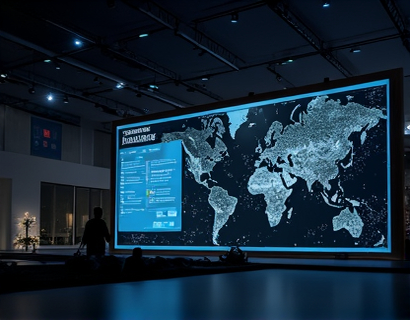Next-Gen QR Code Solutions: Elevating Business Engagement and Social Media Interaction for Modern Enterprises
In the rapidly evolving digital landscape, businesses and social media managers are constantly seeking innovative ways to enhance engagement and interaction with their audience. One such technology that has emerged as a game-changer is the next-generation QR Code, often referred to as enhanced or intelligent QR Codes. These advanced QR Codes are not just a simple upgrade from their traditional counterparts; they offer a suite of features that significantly elevate the way brands connect with consumers and foster deeper, more meaningful interactions.
The evolution of QR Codes into next-gen solutions is driven by the need for more interactive, customizable, and user-friendly tools. Traditional QR Codes, while effective in basic applications, have limitations when it comes to providing rich, dynamic content and seamless user experiences. Next-gen QR Codes address these limitations by integrating advanced technologies such as NFC, augmented reality (AR), and real-time data updates, making them indispensable for modern enterprises looking to stay ahead in the digital race.
Enhanced Content Delivery
One of the primary advantages of next-gen QR Codes is their ability to deliver rich, multimedia content. Unlike standard QR Codes that typically link to a static URL, advanced QR Codes can direct users to interactive web pages, videos, 3D models, and even virtual reality (VR) experiences. This capability allows businesses to create immersive and engaging content that captivates the audience and leaves a lasting impression. For instance, a retail brand can use a next-gen QR Code to showcase a product in 3D, allowing customers to explore its features from all angles before making a purchase decision.
Moreover, next-gen QR Codes can dynamically update their content without the need for physical changes. This means that businesses can refresh information, promotions, or even entire campaigns on the fly, ensuring that the content remains relevant and timely. For example, a travel company can use a QR Code that, when scanned, provides the latest flight deals, hotel offers, and travel tips, all of which can be updated in real-time based on user interactions and preferences.
Customization and Branding
Customization is another key feature of next-gen QR Codes. These advanced codes can be tailored to match a brand's identity, including logos, colors, and design elements. This level of personalization not only enhances the visual appeal of the QR Code but also reinforces brand recognition and loyalty. When a customer scans a QR Code that aligns with the brand's aesthetic, it creates a cohesive and professional experience that resonates on a deeper level.
For instance, a luxury fashion brand can design a QR Code that reflects its elegant and sophisticated image, complete with a custom logo and color scheme. When customers interact with this QR Code, they are immediately immersed in a branded experience that aligns with the high-end values of the brand. This not only improves engagement but also builds a stronger emotional connection with the audience.
Interactive and Gamified Experiences
Next-gen QR Codes are not just about static information; they can also be used to create interactive and gamified experiences that engage users in unique and fun ways. By integrating AR technology, businesses can transform a simple QR Code scan into an interactive adventure. For example, a gaming company can use a QR Code to launch a mobile game, where scanning the code not only downloads the game but also triggers an AR experience that brings the game's world to life in the user's environment.
Similarly, in the education sector, next-gen QR Codes can be used to create interactive learning modules. A university can place a QR Code on a campus map that, when scanned, provides an AR tour of the campus, complete with historical facts, student testimonials, and virtual guides. This not only enhances the visitor's experience but also provides a memorable and educational interaction.
Real-Time Data and Personalization
One of the most powerful features of next-gen QR Codes is their ability to interact with real-time data. This means that the content displayed can be dynamically generated based on user behavior, preferences, and location. For instance, a retail store can use a QR Code that, when scanned, shows personalized product recommendations based on the customer's previous purchases and browsing history. This level of personalization not only improves the shopping experience but also increases the likelihood of conversion.
In the context of events and conferences, next-gen QR Codes can be used to provide attendees with real-time updates, schedules, and speaker information. By scanning a QR Code at the event, attendees can access a personalized dashboard that adapts to their interests and provides relevant content, networking opportunities, and even live polls and Q&A sessions. This not only enhances the attendee experience but also fosters greater engagement and interaction.
Enhanced Security and Authenticity
Security and authenticity are critical concerns in today's digital world, and next-gen QR Codes offer advanced solutions to address these issues. These codes can incorporate security features such as encryption, watermarks, and tamper-evident designs to ensure that the information they direct to is genuine and untampered. This is particularly important for industries dealing with sensitive information, such as finance, healthcare, and government services.
For example, a financial institution can use a next-gen QR Code to provide secure access to online banking services. The QR Code can be designed with multiple layers of security, ensuring that only authorized users can access their accounts. This not only protects customer data but also builds trust and confidence in the brand.
Integration with Social Media
Next-gen QR Codes seamlessly integrate with social media platforms, enabling businesses to extend their online presence and interaction beyond traditional websites and apps. By scanning a QR Code, users can be directed to a brand's social media profiles, where they can engage with content, follow the brand, and participate in community discussions. This integration helps to drive traffic to social media channels and increase overall online engagement.
For instance, a music label can use a QR Code to promote an artist's social media accounts, allowing fans to easily follow and engage with the artist's latest releases, behind-the-scenes content, and live performances. This not only enhances the fan experience but also helps to build a loyal and active community around the artist.
Case Studies and Real-World Applications
To better understand the impact of next-gen QR Codes, let's explore a few real-world applications across different industries.
In the hospitality sector, a luxury hotel chain implemented next-gen QR Codes on their room keys. When guests scan the QR Code, they are greeted with a personalized welcome message, access to hotel amenities, and a curated list of local attractions and dining options. This not only enhances the guest experience but also provides valuable data on guest preferences and behaviors, which can be used to improve future services.
In the healthcare industry, a hospital used next-gen QR Codes on patient wristbands to streamline the check-in process and provide quick access to patient records. Scanning the QR Code at the entrance not only verifies the patient's identity but also retrieves their medical history and appointment details, reducing wait times and improving efficiency.
In the education sector, a university implemented next-gen QR Codes on campus maps to offer an interactive tour experience. Students and visitors can scan the QR Code to access AR content that highlights key campus landmarks, historical facts, and upcoming events. This not only enhances the visitor's experience but also serves as a powerful marketing tool to attract new students and visitors.
Challenges and Considerations
While next-gen QR Codes offer numerous benefits, there are also challenges and considerations that businesses should keep in mind when implementing these solutions.
First, the adoption of next-gen QR Codes requires a certain level of technological infrastructure and user familiarity. Businesses need to ensure that their target audience is comfortable using QR Codes and has access to devices capable of scanning them. Providing clear instructions and support can help overcome these barriers.
Second, the quality and reliability of the QR Code generator and the backend system are crucial. Poorly generated QR Codes can lead to failed scans and frustrated users. It's essential to partner with reputable providers that offer high-quality, reliable solutions.
Third, privacy and data security must be prioritized. When using QR Codes that access personal data or sensitive information, businesses must comply with relevant data protection regulations and ensure that user data is handled securely.
Conclusion
Next-gen QR Codes represent a significant advancement in the way businesses and brands interact with their audience. By offering enhanced content delivery, customization, interactivity, real-time data integration, security, and social media integration, these advanced codes provide a powerful tool for modern enterprises looking to elevate their digital presence and foster deeper connections with their audience. As technology continues to evolve, the potential applications and benefits of next-gen QR Codes will only grow, making them an essential component of any forward-thinking digital strategy.










































